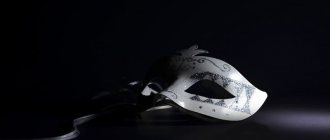How to learn to understand people based on their gestures and facial expressions? The psychology of facial expressions and gestures provides the answer to this question.
By studying and understanding this topic, you can ensure the absence of secrets and hidden meanings in conversations with others and learn to read people like an open book.
Do you agree that this ability is very useful?
General information and definitions
Physiognomy is the art of reading a person by his external signs, in particular by his face, his expression, features and facial expressions. You can determine both internal qualities and some psychological data, as well as health status. This method cannot be called completely scientific, but many are very seriously interested in it due to its certain validity. Facial expressions are facial expressions in which a person reveals his inner sensations, experiences, feelings, mood, emotions and other spiritual qualities. Gestures are body movements, most often with the hand/hands, that accompany or replace the words of the individual performing them. Posture is the position of the body. A person sits, stands or lies the way he likes/convenient/comfortable.
Gestures, postures, facial expressions - all this plays an important role in people's lives. Not a single person can live without them, and therefore, if you learn to recognize them correctly, life will become easier and more interesting. Facial expressions and gestures in communication are used everywhere and automatically; not everyone is able to control them. Thanks to this, more observant and attentive individuals have the opportunity to study people.
The concept of nonverbal communication in psychology
Gestures, facial expressions, pantomimes (as means of communication) are methods of non-verbal contact or a way of speaking without the help of words. In many materials on this topic, the definitions of nonverbal behavior, communication and communication are used as synonyms, but experts share these concepts that are close in meaning.
Nonverbal communication expresses the emotional states of those in contact and the nature of their communication. It includes non-verbal codes, signs and symbols independent of the social and psychological properties of the individual, which significantly increase the accuracy of the transmitted information.
Nonverbal behavior consists of body movements, gestures, glances, facial expressions and pantomimes that can show a person's attitude, reaction or signal something.
Non-verbal communication combines behavior and communication as the main ways of influencing an interlocutor, establishing interaction with him, creating an image and idea of a partner.
These means of information exchange, which include gestures, facial expressions and pantomime, are also called:
- natural;
- primary;
- secondary;
- artificial languages.
Face and facial expressions
What tells you best about a person? Of course, the face. It is this that is capable of giving away a person when he experiences some emotions, reacts to something, lies or tells the truth, etc. The language of facial expressions is rich and varied. It can be difficult to remember absolutely everything, but elementary features of sincere joy, for example, or disappointment can be retained in memory. And also learn to hide your own feelings. Despite the fact that human facial expressions and gestures are closely interrelated, they will be considered separately. So, let's go.
Scientific research
Representatives of Ancient Rome already possessed the study of body language and the desire to characterize gestures. The science formed on the basis of the observations of researchers was called kenesics. The greatest contribution to its development was made by:
- J. Balwer. He created a fundamental work devoted to gestures, in particular, hand movements.
- I. F. Lavater. He studied physiognomy and conducted a comparative analysis of emotions and gestures.
- G. K. Lichtenberg. He published several works in which he examined Lavater’s ideas in detail, calling them superficial and far from reality.
- C. Bell. He studied the nervous system, studied the correspondence of facial features to the emotions experienced. He deduced a pattern between emotional reaction and muscular activity.
- C. Darwin. Studied the correspondence of facial expression to emotional reaction.
- F. Bacon. I came to the conclusion that there is a special body language that is understood by all peoples of the world.
- F. Lowen. In his book on the psychology of the body, he outlined the basics of psychosomatic problems
Psychologists and sociologists believe that body language can become a universal means of communication between people of different social groups.
Reactions
Human facial expressions manifest themselves in different ways, and most often they can be seen in human emotions. The latter, in turn, are shown in reactions. Depending on their manifestation, you can find out what a person experiences from the information received. The difficulty is that some are afraid, others don’t want to, and still others are embarrassed to show their own emotions. Because of this, you will have to have time to notice the quick, involuntary reaction that appears very first. It is often almost impossible to completely control it, especially for an unprepared person. Therefore, you can determine the real feelings of your interlocutor, which he will most likely remove from his face in seconds, if you act quickly and extremely carefully.
Emotions
So let's continue. As mentioned just above, facial expressions in communication are manifested through the expression of emotions emanating from a reaction. Below are the most striking and significant of them, as well as ways of expressing them:
- Joy happiness. The eyebrows and lips are relaxed, the corners of the latter are raised on both sides, the cheeks are also raised, and there are small wrinkles in the corners of the eyes.
- Anger, irritation. The eyebrows are tense, brought together and lowered, the mouth is tightly closed. Often the teeth are brought together, as are the lips, the corners of which look down during anger or strong dissatisfaction.
- Contempt. Smirk. The corner of the mouth is raised on one side and a slight squint is visible in the eyes.
- Astonishment. The lips and face are generally relaxed, the eyes are rounder than usual, the eyebrows are raised up, and the mouth is slightly open.
- Fear. The eyebrows and upper eyelids are raised, and the lower ones are tense, like the whole face as a whole, the eyes are wide open.
- Sadness, disappointment. Slightly lowered upper eyelids and raised eyebrows, relaxed lips with corners looking down, as well as an empty, dull look.
- Disgust. The upper lip is tense and raised, the eyebrows are brought together, forming a small fold, and slightly lowered, the cheeks are also slightly raised, and the nose is slightly wrinkled.
Among other things, pictures will help you deal with emotions. The facial expressions on them are depicted well, which clearly demonstrates the inner feelings and experiences of the people depicted. Smiles, by the way, were also not invented in vain. Their facial expressions are often quite good, which is why they are in demand when trying to convey emotions via the Internet. After all, communication here mainly takes place in letters, which are not always able to convey the sensations experienced at one time or another.
Expressions of feelings and emotions through nonverbal signals
Gestures, facial expressions, pantomimes (as means of communication) are optical-kinetic types of information exchange. In them, distance, body movements, intonation and appearance matter. According to psychological research, women express their feelings more accurately and are better at understanding the feelings of others.
People employed in communication-related professions such as teaching, psychology, and acting have similar accurate perceptions.
Among the common characteristics of various human emotions and feelings, the following combinations of nonverbal signs can be distinguished:
- A dreaming person raises the inner ends of his eyebrows high and looks up. The corners of his mouth may be located asymmetrically.
- Embarrassment can be identified by downcast eyes and a closed smile with one side of the mouth and the inner ends of the eyebrows raised.
- Strong hidden tension is expressed in tightly clasped fingers and clenched hands. The level of tension is proportional to the force of squeezing the fingers and hands. Other symptoms include nervous rubbing of fingers and hands together, high hand mobility, handling paper clips, and rotating writing objects. A person experiencing mental stress may look towards the window or door, unconsciously expressing a desire to leave the room, suddenly get up and walk around the room.
- Signs similar to indicators of tension are shown by people in an aggressive state, but indicators of aggression have their own specifics. Gestures become more expressive, a person can point with a finger, slam doors and clench his fists.
- Irritability, nervousness and uncertainty are manifested by frequent yawning, coughing similar to clearing the throat, fidgeting in the chair, frequently looking away from the interlocutor, shaking keys or coins in the pocket.
- A person having insidious thoughts looks with squinting eyes. The outer ends of his eyebrows are raised, and his lips are tightly compressed and form a semblance of a smile.
- The desire for contact and interaction can be indicated by sitting on the front edge of the seat, leaning the torso forward, an unbuttoned jacket, friendly intonations and gestures next to the speaker’s face. If the person is open, his arms are slightly extended forward, to the sides and perform circular movements, and his palms are visible.
- Stealth or a desire to hide something can be indicated by mechanically closing the mouth with one or two hands, rubbing the chin or temples with fingers, averting the eyes and tilting the body away from the interlocutor.
- In addition to the described signs of confidence, it can be characterized by leisurely walking back and forth and folding the arms in front of oneself in a dome in a sitting position, when the fingers are joined on top and the palms remain at a distance. This gesture can also be interpreted as an intention to conduct a dialogue, but from a position of dominance. The greater the confidence of the person folding his hands in this way, the higher this “dome” is located.
- Determination is manifested in tightly clenched jaws, a frowning glance and a sharp constriction of the pupils.
- Closedness and the desire to distance oneself is characterized by the castle pose. It consists of arms crossed on the chest with clenched fists and legs thrown one on top of the other. The need for distance can be manifested by tilting the torso back from the interlocutor when sitting.
- Pursed lips, averted gaze, and low-lowered eyelids and eyebrows can indicate resentment.
- Self-control may be expressed differently in men and women. Seated men grip the armrests if available, their ankles are crossed and their legs are slightly extended forward. When speaking from the podium, self-control and confidence are demonstrated by having your hands pointing forward and firmly holding the sides of the podium. The most common expression of self-control in women is to place their thumb behind a belt or skirt.
- A person with cunning thoughts averts his eyes to the side, lifting one of the corners of his mouth.
Thanks to gestures, facial expressions and intonations, you can significantly diversify communication and give your words an appropriate emotional coloring, making them easier to understand by your interlocutor.
Nonverbal means of communication can change the meaning and strength of the effect of speech, due to which they are of increased interest among politicians, media workers, businessmen and careerists. Pantomime and other means of assessing a person’s state, intentions and influence on him are in demand in psychology and the work of law enforcement agencies.
Some interpretations of various nonverbal indicators may be either coincidence or the result of factors irrelevant to the situation. Judicious use of non-verbal information exchange means can serve to entertain and enrich human relationships.
Human condition
Sometimes it is enough to observe people a little to see what they are like. Facial expressions affect a person, and not only “one-time”, but for the rest of his life. The more clearly your interlocutor showed himself, the more you can find out about him. — Smart people most often have a large forehead. This does not mean that their knowledge is great in everything. Sometimes it happens that a person knows a lot of information in one area, but is completely ignorant in another. If your friend has a large forehead, but does not show any signs of special intelligence, perhaps he simply has not yet found his business.
— Brilliant eyes and a lively look mean that a person is passionate about someone/something. This usually happens to curious children who are interested in everything in the world. On the contrary, if a person’s gaze is dull and indifferent, it means that he is depressed, perhaps close to depression.
— If a lot of wrinkles appear in the corners of the eyes when laughing, this means that the person is kind, cheerful and cheerful.
— Bitten lips mean that a person likes to think and is most often nervous when making a decision. Sometimes people automatically begin to act this way right in front of their interlocutor, because they cannot decide something.
— A firm, developed chin (often square) shows a person’s strong will. Because people, when achieving their goals (even in an argument), tense the lower part of the face, it begins to develop. With frequent victories, the chin becomes strong and firm, which proves a person’s ability to achieve his goals. Based on this, if the lower part of the interlocutor’s face is soft, weak and undeveloped, it can be assumed that he is easy to break. He will not go to the end if a serious obstacle appears ahead.
— The more various bulges, irregularities, “hollows”, “protrusions”, etc. on the face (sunken cheeks, prominent cheekbones, for example), the more emotional and hot-tempered a person is. He can easily fall into a state of passion and vividly and vividly throw out his experiences on those around him.
How to recognize gestures?
In order to feel confident and comfortable in a situation of communicating with different people, to avoid manipulation, you should learn to recognize non-verbal language of communication in situations where they are trying to deceive you.
What means of nonverbal communication, gestures, postures, and facial expressions should you pay attention to in order to recognize a lie?
- excessively long or frequent pauses, pauses and hesitations before starting a line;
- asymmetry of facial expressions, lack of synchrony in the work of facial muscles, when there is a discrepancy in the facial expressions of the two sides of the face;
- a “frozen” facial expression, when it does not change for 5-10 seconds, is false;
- delayed expression of emotions, when long pauses arise between the word and the emotions associated with it;
- a “long” smile, where the lips are pulled back from the teeth, creating a narrow lip line;
- visual contact is shallow, when the liar's eyes meet the interlocutor's eyes for no more than a third of the entire conversation, while often looking at the ceiling and around with a restless expression on his face;
- twitching of any part of the body: tapping fingers on the table, biting the lip, twitching of arms or legs;
- scanty gestures that the liar keeps under control;
- high pitched voice, heavy breathing;
- bent body, crossed-legged poses;
- poor facial expressions, weak work of the facial muscles;
- quickly moving the eyes first to the upper right corner, and then to the lower left;
- quick, imperceptible at first glance, touching the nose, rubbing the eyelid;
- brighter gestures with the right hand compared to the left;
- any exaggeration: unnecessary movements and gestures, inappropriate emotions;
- frequent eye blinking
Knowing all the subtleties of non-verbal communication techniques, you will not only be able to avoid manipulation, but you yourself can easily learn how to manage people
The main thing that any student of body language strives for is the ability to detect lies in the speech of the interlocutor. They say about dishonesty:
- Frequently touching the face, scratching the forehead and nose, covering the mouth with the hand. A person literally tries to stop himself from telling a lie, to cover his face, avoiding a direct condemning gaze.
- Stroking, scratching the neck. Talks about lies caused by fear or misunderstanding. Such gestures are often demonstrated by subordinates when talking with their boss.
- Touching the earlobe. During communication, touching the ears means that the person does not believe in the information he heard, but tries not to show it.
- Quick, frequent smiles, licking lips. It means excitement, a desire to hide deception.
To get a complete picture of the correspondence of gestures and facial expressions to a person’s words, you need to evaluate the meaning of all movements:
- Gait. By the way the interlocutor enters the room, you can assess the degree of confidence and self-esteem: a long step, a confident gait - purposefulness and ambition, a shuffling gait - lack of will and aspirations, a slow, imposing gait - narcissism and demonstrativeness.
- Hand position while moving and sitting. Elbows pressed to the body indicate isolation, unsociability; broad gestures, waving your arms when talking - openness, sociability. Touching your interlocutor is a desire to enter the zone of closest trust, a desire to subjugate.
- Direction of view. The position of the eyes shows how interested the interlocutor is in the conversation and the desire to defend his point of view. A downward gaze means the person is telling the truth; an upward gaze means he makes it up as he goes along.
- Posture. A straightened neck and a raised chin indicate a person’s general confidence; a bowed head is a sign of humility and timidity.
- Body direction. A body leaning forward means interest in the conversation, sympathy for the interlocutor, a desire to reduce the emotional distance, and gain trust.
If a person often changes position during a conversation, his opinion is unstable. He is ready to accept someone else's point of view and submit to his interlocutor.
Gesticulation
Both facial expressions and gestures in communication make it clear what and how a person says:
- Open palms signify trust and openness. If a person periodically exposes the inside of his hand to you, it means that he has nothing to hide from you, and he feels good in your company. If the interlocutor constantly hides his hands in his pocket, puts them behind his back, or makes other similar “secretive” movements, he is probably not very comfortable. This could be either dislike towards you or guilt/shame for past actions.
- Hands placed near the cheek mean thoughtfulness. Usually at such moments a person thinks intensely about something, tries to figure out what to do in a given situation, etc.
- When nervous or, more likely, lacking self-confidence, a person begins to touch either his neck or objects on it such as a pendant, chain, etc. In addition, he may begin to chew on the handle.
- A nod of the head signifies agreement. Sometimes people nod uncontrollably, thereby communicating on a subconscious level that they like someone else's opinion. Shaking your head, on the contrary, means that the person does not agree with you. Just like nodding, sometimes it happens automatically.
The importance of interpersonal space
When considering various types of nonverbal communication, special attention should be paid to the importance of interpersonal space. It is this instrument that plays a significant role when trying to establish contact in communication. Frequently used expressions such as “stay away from him” and “want to be close to him” clearly show the importance of this tool. In a situation where people show subconscious interest in each other, they tend to reduce the space between them. In some situations, such behavior is unacceptable, which forces a person to adhere to a certain framework of communication.
Nonverbal communication between a man and a woman who are interested in each other is carried out at a distance of less than fifty centimeters. For this distance the term “intimate” is used . Such a distance is allowed in communication with the other half, close friends, as well as in some sports that involve physical contact. During a friendly conversation, the interlocutors are most often located at some distance from each other. Most often they are located at a distance from half a meter to one hundred and twenty centimeters. This distance is called interpersonal space.
Today, 60% of communication between people is the non-verbal part, what people convey to each other with their bodies, through posture, gestures and facial expressions
The social space between people having a conversation ranges from one hundred and twenty to three hundred and seventy centimeters. Most often, such examples can be seen during business conversations. The formality of the conversation is determined by the distance between the participants in the negotiations. A distance of more than four meters between people is called public space. As the name suggests, this distance is more comfortable for public speaking in front of an audience.
When establishing certain boundaries in communication, one should take into account the gender and age of a person, as well as some features of his personality. Psychologists say that children often try to position themselves as close to their interlocutor as possible, while teenagers feel the need for some detachment . Women, like children, like to talk at a closer distance. Psychologists also say that for people with self-confidence, the distance at which a conversation is conducted is rarely of particular importance, while people with problems with self-esteem try to subconsciously distance themselves from the person.
Poses
Open facial expressions and gestures in communication are, of course, good, but we must not forget about the postures a person takes during a conversation:
- If a person sits relaxed, with his legs stretched forward, in your direction, this means that he is in a favorable mood. Approaching your interlocutor with a chair has the same meaning: a predisposition towards you personally and the conversation as a whole.
- Sometimes a person unfastens buttons, or even takes off clothes, such as a jacket. This proves his trust and open attitude towards you.
- If your interlocutor draws something simple on a piece of paper, often looks at one point, fiddles with a pen, shakes his leg, taps his fingers, does not express any special emotions, etc., it means that he is not very interested in you, because this signs of boredom. Change the topic of conversation or try to add liveliness to the dialogue.
- Crossed legs or arms (on the chest, for example) mean closedness, withdrawal, reluctance to communicate and open up. Perhaps the person simply feels uncomfortable, and this condition will soon pass, or perhaps it is unpleasant for him to be in your company.
Types of nonverbal communication
Gestures, facial expressions, pantomimics as a means of communication, in addition to enriching it, can serve to express emotions, agreement or disagreement, endow the situation with additional meaning, bring those in contact to a different level of mutual understanding and guide the interpretation of speech.
They are often used in education and to communicate with those suffering from hearing loss. Thanks to methods of non-speech information exchange, it is possible to both strengthen and weaken the influence of speech influence.
Some experts equate types of nonverbal communication with ordinary languages due to their information richness. They are classified depending on the types of human perception and how the information received is processed.
In total, there are 9 types of information exchange without the help of words, but this number may change due to the fact that its related types are sometimes combined into one direction.
| Language of nonverbal communication | Scope of use |
| Vocals | Features of the sound of speech and its intonation |
| Haptics | Also called takeshika and refers to meaningful touch. |
| Artifacts | Appearance attributes such as cosmetics, jewelry and clothing |
| Olfactics | Smells |
| Physics | Physical characteristics such as hair color, body shape and size |
| Aesthetics | Color, music |
| Chronicle | Time-based perception |
| Kinesics | Body movements and gestures |
| Proxemics | Perception of public and personal space |
Gestures
The list of communications without the use of speech includes a large number of gestures, with the help of which one can characterize a person’s real thoughts and intentions. The following are the most common combinations of gestures that are signs of certain conditions.
Mistrust:
- palm covers mouth.
Critical attitude:
- one hand supports the elbow of the other hand;
- the hand is located under the chin, and its index finger is extended along the cheek.
Superiority:
- the eyelids are slightly closed;
- hands thrown behind the head;
- sitting position with one leg crossed over the other.
Uncertainty:
- the fingers of one hand clasp the elbow of the other hand;
- touching the ears with your hands, rubbing them, scratching them or touching the earrings.
Boredom:
- stooping or hunching;
- the body is in a relaxed state;
- hand supports head.
Concentration:
- rubbing or pinching the bridge of the nose, handling glasses;
- touching and rubbing your chin with your hands;
- eyes are closed or squinted.
Disapproval:
- tugging and straightening clothes, depicting shaking them off from the dust of movement;
- shrugging shoulders.
Goodwill:
- the body is in a relaxed state;
- the shoulders are in an open position;
- arms spread to the sides;
- the head is directed forward and the palms are up.
Positive attitude:
- hand touching cheek;
- The body and head are tilted forward.
Pose
Body position is one of the determining criteria in assessing the attitude of the interlocutor and his intentions. You can characterize a person’s thoughts and perception of what is happening using the following poses.
Lack of frankness and completeness in dialogue with the interlocutor:
- standing with partial support on a chair, table or other strong support.
Haste or impatience:
- feet or entire body facing the door.
Aggressive attitude, self-confidence, determination to defend your position and fight back:
- one hand holds the elbow of the other hand;
- hands rest on hips or belt;
- the body is slightly tilted forward.
Distrust of the interlocutor or anxiety:
- fencing, an attempt to install a folder, book or other objects as an obstacle;
- legs are in a crossed position;
- arms crossed on chest.
Feeling of superiority or self-confidence:
- chin slightly raised;
- the head is directed straight;
- hands are behind the back.
Aggressive expression of self-confidence (can also be interpreted as a manifestation of sexual desire towards the opposite sex):
- the thumbs of the hands are tucked into pockets or tucked into the waistband of clothing for the lower body.
Mimicry and pantomime
Facial expressions are of particular importance in nonverbal communication. In most cases, facial muscles reflect a person's emotions and thoughts. You can understand the feelings of your interlocutor using the following positions of the facial muscles.
Happiness:
- drawn back and slightly raised corners of the lips;
- calm look.
Anger:
- clenched teeth, indicated by tense cheekbone muscles;
- lips are tightly closed;
- curving folds on the forehead;
- squinted eyes;
- frowned eyebrows.
Fear:
- slightly open mouth;
- eyes wide open;
- lips slightly apart;
- eyebrows slightly close to the bridge of the nose and raised;
- drawn back and slightly lowered corners of the lips;
Sadness:
- the corners of the lips are slightly lowered;
- dull look;
- eyebrows close to the bridge of the nose.
Disgust:
- the lower lip is in close contact with the upper lip or protrudes slightly;
- the end of the nose is wrinkled;
- brows furrowed.
Astonishment:
- the corners of the mouth are lowered;
- eyes wide open;
- the mouth is slightly open;
- eyebrows raised.
A more extensive section of pantomime covers movements of the body and facial muscles, gestures, as well as features of posture and gait. In addition to its use in psychology, pantomime has wide application in the theater.
Actors master the art of pantomime in the early stages of training, acquiring the skill of establishing an invisible connection with a partner and interacting only with a person’s internal sensations.
The direction of pantomime is sometimes called bodily mimicry. Thanks to the complex combinations of its characteristics, it is possible to draw up a preliminary characterization of a person, guided only by his gait and ordinary physical actions. In addition to the current state of the individual, one can evaluate his learning ability, character, susceptibility to hypnosis and other qualities.
Representatives of one gender or profession have the most accurate understanding of pantomime outside the psychological environment.
Sight
The direction of the pupils and the position of the eyelids also lend themselves to classification as means of nonverbal communication. Below are their most common interpretations.
Gestures, facial expressions, pantomimes are not only means of communication, but also ways to catch someone lying
Calm look:
- prudence;
- tranquility;
- satisfaction with the speech of the interlocutors or with one’s condition.
Point-blank look:
- self confidence;
- willingness to communicate;
- self-respect or respect for the interlocutor.
Top down view:
- feeling of superiority over an opponent.
Looking “through” the interlocutor:
- aggression;
- contempt.
Side view:
- desire to maintain distance;
- showing skepticism;
- puzzled;
- mistrust.
Bulging eyes:
- unexpected fear;
- sudden joy.
Looking “inward”:
- deep thoughtfulness;
- feeling of enchantment.
"Sparkling Eyes":
- nervous tension;
- uncertainty;
- puzzled.
View from below:
- desire to please;
- subordination.
The eyelids are in a closed position:
- disinterest in what is happening;
Eyes slightly narrowed:
- increased attentiveness and observation to the interlocutor or events.
Distance
Proxemics studies the attitude of interlocutors to the distance between them. People perceive the space around them as a sphere, whose size is determined by their current state, culture and social environment. The amount of space between those in contact determines the nature of their communication, which is also influenced by the spaciousness of the environment where the interlocutors are located.
Communication distance is divided into 3 types:
- informal space is the territory surrounding a person, perceived by him as intimate and personal;
- fixed space - an area that has fixed boundaries, for example, the walls of a room;
- semi-fixed space is an area subject to change, where, for example, furniture is rearranged.
Interlocutor intimacy norms vary depending on a person's cultural background.
The following standards are defined in European culture:
- the intimate area is within 35 cm of the human body;
- personal space begins after 0.3 cm and ends at a distance of 1.3 m;
- the social territory is within the boundaries of 1.3 m to 3.7 m from a person;
- public space begins at the far end of the social.
Intonation
The meaning of words is greatly complemented by the tone in which they are spoken, as well as their intonation and volume.
The following signs can indicate the state of the speaker or his attitude towards something:
- agitation is characterized by intermittent and fussy speech and a low tone;
- pauses and confused speech indicate uncertainty;
- fatigue is indicated by slow speech with lower intonation towards the end of the phrase and a low tone;
- with inspiration and enthusiasm, speech is clear and precise, the tone is high;
- arrogance is characterized by slow and monotonous speech.
Cloth
What a person wears is the main criterion of artifacts, which in this regard can intersect with physics.
For nonverbal communication, it is important not only that clothing matches the setting, style and social status, but also the physical characteristics of the person wearing it. People's perception of a particular outfit can be individual and largely depends on the situation.
How to recognize truth and lies from a person
That’s why many people are interested in the details of our article - everyone wants to know how to read a person’s facial expressions, how to see when they are blatantly lying to you, and when they are telling the pure truth. Some ways to expose a liar are given below, but remember that, perhaps, the liar has known about such tricks for a long time, and therefore uses them skillfully and dexterously, deceiving others in such a way that a mosquito will not undermine his nose.
- When a person tells a lie, his pupils involuntarily constrict. If you have previously noticed the initial state of the interlocutor’s eyes, then you will understand that he is being disingenuous after the pupils become smaller.
- When a person lies, he looks away. This happens because he is subconsciously ashamed of the false information he says.
- When a person is lying and knows about the previous method, he looks intently into the eyes. Most often, he gets so “played” that he barely even blinks. This can also reveal a liar.
- The gaze of a lying person moves from one object to another, without stopping at one thing. Sometimes it's just a sign of nerves, but more often it's a sign of lies.
- Thanks to the compression of the zygomatic muscles, a kind of half-smile, half-grin appears on the face of the lying person.
- The direction of your gaze will also tell you whether you are hearing the truth or a lie from your interlocutor. If a person looks to the right, most likely, you are being presented with a lie, if to the left, the truth. However, this rule applies provided that the speaker is right-handed, otherwise read backwards.
Features of foreign language of facial expressions and gestures
Not everywhere they communicate in the same ways as here. Of course, this does not mean human language, but the language of gestures, postures and facial expressions. The list below, indicating specific countries and incorrect actions, will help you avoid getting into trouble with foreigners. Asia. Watch your arms and legs. You should not be the first to touch someone else’s head and hair, because for Asians this is the most sacred thing in a person. The legs, in turn, also don’t need to be loosened, though not at all. Even an accidental touch (to any part of the body) can cause panic and even anger on the part of Asians. This is because, unlike the head, the legs are considered the “lowest” thing in the human body. Near East. Giving a thumbs up is the same as giving a person a punch in the ass. Children, however, often show this gesture, thereby trying to tease others. Brazil. The “everything is okay” gesture (the thumb is connected to the index finger, forming a zero, and the remaining fingers stick out “out”) here has approximately the same meaning as our middle finger. Venezuela. The “everything is okay” gesture here denotes homosexuality. Italy. The “Goat” gesture from rock music here signifies betrayal and failure. That is, if you show this sign to someone, you are hinting that you consider him a complete loser who is being cheated on by his other half. In northern Italy you are also not allowed to touch your chin, as this means you are giving the person the middle finger. Fiji. A handshake is considered a trademark of the republic, which is why you should not be afraid if the interlocutor holds your hand tightly and for a long time in his. This is just a sign of politeness, and it can really last a considerable amount of time, right up to the end of the conversation. France. The “everything is okay” gesture here denotes homosexuality, and scratching the chin is the same middle finger.
How to learn to understand body language better?How to learn to understand body language better?
1. To begin with, you can again look through the album with photos, especially group ones. Look at how, in what sequence, the characters stand, where they look, how they smile, what their posture is in general, how they relate to each other.
2. The same can be done with other people’s photographs, because in this case, all the characters depicted will be unfamiliar to you.
3. At the next stage, you can start observing the people around you on the street, in a traffic jam, subway, in a cafe or cinema. You risk seeing a lot of interesting things. Suddenly you want to write a book. You never know!
4. Now is the time to observe your own body language. Videos from parties, feedback from loved ones, friends and colleagues can help you with this. You will be surprised how what you do differs from how you imagine it. You will have something to work with, although you can leave everything as it is. You decide.
5. News releases, no matter how you feel about them, can serve you well. Your task is simply to turn off the sound and watch the announcer. After a while, even without his words, you will understand where and what exactly is bad in our troubled world.
advertising is not displayed
6. If watching the news is completely unbearable, then films will help. Just watch your favorite movie without sound. You have the opportunity to catch many shades that you had not noticed before. And if you watch a new film from start to finish, and even without sound, then this is aerobatics!











